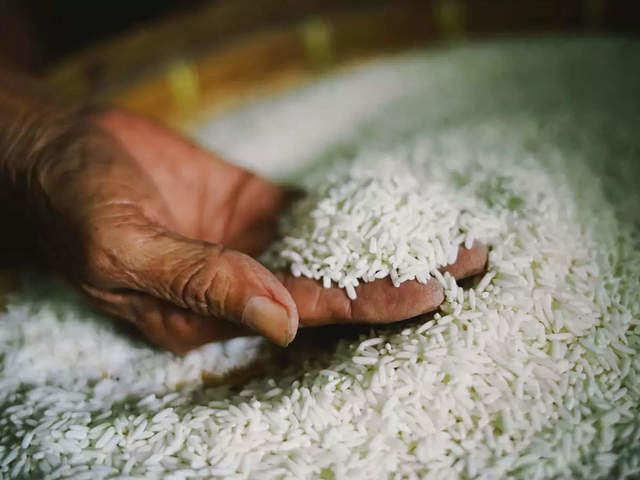India's basmati rice production to be higher than last year's level due to monsoon boost

Agencies
Basmati rice will start arriving in the market from September, when buyers from overseas markets start placing orders for the new crop.
Synopsis
“Production of basmati rice will be higher this year, which is good for the industry. Domestic consumption is increasing and newer markets for exports are opening up,” said Vinod Kaul, executive director of All India Rice Exporters Association (AIREA). “Even though payments from Iran is still due, but we are getting good export orders from Middle-east countries like Saudi Arabia and Iraq. Eastern European countries are also keen to buy basmati rice from us.”
KOLKATA: India’s basmati rice production this year is likely to be 7% higher than last year’s level at 8 million tonnes, according to a rice exporters’ association, thanks to good rains and availability of farm hands during the sowing period.
“Production of basmati rice will be higher this year, which is good for the industry. Domestic consumption is increasing and newer markets for exports are opening up,” said Vinod Kaul, executive director of All India Rice Exporters Association (AIREA). “Even though payments from Iran is still due, but we are getting good export orders from Middle-east countries like Saudi Arabia and Iraq. Eastern European countries are also keen to buy basmati rice from us.”
Basmati rice producers had been worried that the exodus of migrant workers after the coronavirus outbreak would slow down sowing and lower production. But sowing was completed with the help of local labourers and the migrant workers who returned after lockdown measures were eased.
“Local labourers as well some migrant workers who had returned have completed the sowing. Crop size will be higher this year,” Vijay Sethia, former president of AIREA, said.
In the last kharif season, the country had produced 7.5 million tonnes of basmati rice. “This year, the acreage has increased and we are expecting 80 lakh (8 million) tonnes of rice,” said AIREA’s Kaul.
India exports 4.4-4.5 million tonnes of basmati rice every year, the major chunk of which goes to Iran.
“We have stopped shipments to Iran. The exporters are not taking any new orders,” said Kaul. “We are not sure when the exporters will get back their money against the export orders,” Kaul said.
Basmati rice will start arriving in the market from September, when buyers from overseas markets start placing orders for the new crop. “As of now, the countries which need basmati rice immediately are placing orders,” Sethia said.
According to Gurnam Arora, joint managing director of Kohinoor Foods, some Europe countries that have been badly affected due to Covid-19 are placing orders with Indian basmati rice exporters. “For instance, Italy is buying good volumes from India. Similarly, buyers from London are also importing basmati rice. The export markets are gradually opening up,” Arora said.
According to APEDA, India exported 4.454 million tonnes of basmati rice worth Rs. 31,025.91 crore in FY20.
Prices of the common basmati varieties have remained firm in the Rs 850-1,000 per kg range.
“Production of basmati rice will be higher this year, which is good for the industry. Domestic consumption is increasing and newer markets for exports are opening up,” said Vinod Kaul, executive director of All India Rice Exporters Association (AIREA). “Even though payments from Iran is still due, but we are getting good export orders from Middle-east countries like Saudi Arabia and Iraq. Eastern European countries are also keen to buy basmati rice from us.”
Basmati rice producers had been worried that the exodus of migrant workers after the coronavirus outbreak would slow down sowing and lower production. But sowing was completed with the help of local labourers and the migrant workers who returned after lockdown measures were eased.
“Local labourers as well some migrant workers who had returned have completed the sowing. Crop size will be higher this year,” Vijay Sethia, former president of AIREA, said.
In the last kharif season, the country had produced 7.5 million tonnes of basmati rice. “This year, the acreage has increased and we are expecting 80 lakh (8 million) tonnes of rice,” said AIREA’s Kaul.
India exports 4.4-4.5 million tonnes of basmati rice every year, the major chunk of which goes to Iran.
“We have stopped shipments to Iran. The exporters are not taking any new orders,” said Kaul. “We are not sure when the exporters will get back their money against the export orders,” Kaul said.
Basmati rice will start arriving in the market from September, when buyers from overseas markets start placing orders for the new crop. “As of now, the countries which need basmati rice immediately are placing orders,” Sethia said.
According to Gurnam Arora, joint managing director of Kohinoor Foods, some Europe countries that have been badly affected due to Covid-19 are placing orders with Indian basmati rice exporters. “For instance, Italy is buying good volumes from India. Similarly, buyers from London are also importing basmati rice. The export markets are gradually opening up,” Arora said.
According to APEDA, India exported 4.454 million tonnes of basmati rice worth Rs. 31,025.91 crore in FY20.
Prices of the common basmati varieties have remained firm in the Rs 850-1,000 per kg range.
:https://m.economictimes.com/news/economy/agriculture/indias-basmati-rice-production-to-be-higher-than-last-years-level-d

services are quite good but can be improved
ReplyDeleteRegards
Mozocare